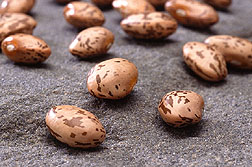| January 2008 |
Fast-Acting Carbs May Hasten Vision Loss Over Time
Consuming higher-than-average amounts of so-called "fast carbohydrates" that cause blood sugar levels to spike and fall rapidly could be a risk factor for central vision loss with aging. Scientists supported by the Agricultural Research Service (ARS) and grants reported these findings this year in the American Journal of Clinical Nutrition. Consuming a diet high in fast carbs is also suspected of being involved in the vision loss that sometimes occurs in people with diabetes. Scientific contact: |
|
Eating Beans Helps Lower Cholesterol
Consuming as little as one-half cup of cooked dry beans every day helped volunteers lower their total cholesterol levels in an Agricultural Research Service (ARS) study in North Dakota. These results, published in the November issue of the Journal of Nutrition by the ARS scientists and their colleagues, add to a growing—and convincing—body of evidence that beans are a heart-healthy food choice. Scientific contact: |
Scientist Developing Bread Rich in Beta-Glucan
An Agricultural Research Service (ARS) chemist is baking soft white bread that resembles any store-bought loaf, except for a key difference: its beta-glucan content. Research suggests that, when ingested, this soluble fiber helps the body regulate blood glucose and lower "bad" cholesterol, diminishing the risk of coronary heart disease. The bread owes its 0.75 grams of beta-glucan per serving to C-TRIM, a barley- and oat-bran-based powder developed at the ARS National Center for Agricultural Utilization Research in Peoria, Ill. Scientific contact: |
|
New Campylobacter-Detecting Medium Licensed
A quicker, simpler way to distinguish between Campylobacter species has now been licensed for manufacture by two U.S. companies: Becton Dickinson and Co. of Franklin Lakes, N.J., and Neogen Corp. of Lansing, Mich. An Agricultural Research Service (ARS) scientist began working with Polish scientists in 1987 to develop the new medium, which was patented in 1999. The new culture medium, called Campy-Cefex, is specifically designed to detect and differentiate C. jejuni and C. coli mixtures of food-contaminating microbes. These two bacteria are important causes of foodborne illness. Campy-Cefex selects for Campylobacter among competing flora in a sample, cultivating colonies that resemble tiny water droplets. From these, microbiologists can estimate the level of Campylobacter contamination in the sample. Scientific contact: |
Secrets of Fish Oil Compound Probed
A compound found in oil-rich fish such as salmon reshaped the blood lipid profiles of volunteers in an Agricultural Research Service (ARS)-led study. Blood samples taken after fasting, and within eight hours after meals, showed that DHA reduced the number of small LDL (low-density lipoprotein) particles by 22 percent. LDLµs small particles are the size most harmful to the cardiovascular system. The research, reported earlier this year in the American Journal of Clinical Nutrition, is likely the first to analyze—in high-triglyceride males—DHA's effects on both fasting and post-meal triglycerides, and on quantities and sizes of different types of cholesterol particles. Scientific contact: |
|











